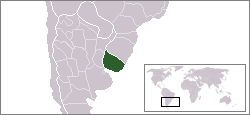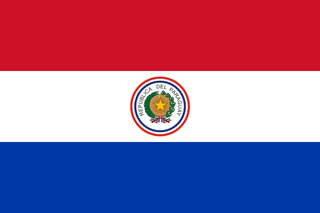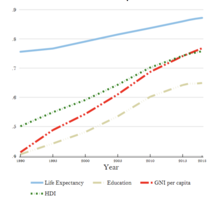The International Bank for Reconstruction and Development (IBRD) is an international financial institution, established in 1944 and headquartered in Washington, D.C., United States, that is the lending arm of World Bank Group. The IBRD offers loans to middle-income developing countries. The IBRD is the first of five member institutions that compose the World Bank Group. The initial mission of the IBRD in 1944, was to finance the reconstruction of European nations devastated by World War II. The IBRD and its concessional lending arm, the International Development Association (IDA), are collectively known as the World Bank as they share the same leadership and staff.

The World Bank Group (WBG) is a family of five international organizations that make leveraged loans to developing countries. It is the largest and best-known development bank in the world and an observer at the United Nations Development Group. The bank is headquartered in Washington, D.C. in the United States. It provided around $98.83 billion in loans and assistance to "developing" and transition countries in the 2021 fiscal year. The bank's stated mission is to achieve the twin goals of ending extreme poverty and building shared prosperity. Total lending as of 2015 for the last 10 years through Development Policy Financing was approximately $117 billion. Its five organizations are the International Bank for Reconstruction and Development (IBRD), the International Development Association (IDA), the International Finance Corporation (IFC), the Multilateral Investment Guarantee Agency (MIGA) and the International Centre for Settlement of Investment Disputes (ICSID). The first two are sometimes collectively referred to as the World Bank.
The International Development Association (IDA) is an development finance institution which offers concessional loans and grants to the world's poorest developing countries. The IDA is a member of the World Bank Group and is headquartered in Washington, D.C. in the United States. It was established in 1960 to complement the existing International Bank for Reconstruction and Development by lending to developing countries which suffer from the lowest gross national income, from troubled creditworthiness, or from the lowest per capita income. Together, the International Development Association and International Bank for Reconstruction and Development are collectively generally known as the World Bank, as they follow the same executive leadership and operate with the same staff.

The World Bank is an international financial institution that provides loans and grants to the governments of low- and middle-income countries for the purpose of pursuing capital projects. The World Bank is the collective name for the International Bank for Reconstruction and Development (IBRD) and International Development Association (IDA), two of five international organizations owned by the World Bank Group. It was established along with the International Monetary Fund at the 1944 Bretton Woods Conference. After a slow start, its first loan was to France in 1947. In the 1970s, it focused on loans to developing world countries, shifting away from that mission in the 1980s. For the last 30 years, it has included NGOs and environmental groups in its loan portfolio. Its loan strategy is influenced by the United Nations' Sustainable Development Goals, as well as environmental and social safeguards.
Morocco's involvement with the World Bank primarily focuses on infrastructure, such as road, transport and water sanitation. In addition the bank supports projects across the health sector, youth development, renewable energy, governance and the support of small and medium enterprises (SMEs). 27 projects are ongoing, including three projects initiated in 2017. The World Bank invested over US$1 billion every year from 2014 to 2016.
Uzbekistan became a World Bank member in 1992, shortly after declaring independence in 1991 following the collapse of the Soviet Union. The World Bank has supported projects in Uzbekistan in the areas of education, infrastructure, agriculture, and water resource management. Uzbekistan's collaboration with the bank has been increasing, with IBRD and IDA lending reaching a recent peak of $500 million in 2015. The World Bank has provided financing for 27 projects through the IBRD and IDA in throughout its relationship with Uzbekistan, with 15 active projects as of June 2017. Current IBRD and IDA projects total $1.9 billion.

Uruguay and the World Bank have been working together for a long time. This is because they both mutually benefit.

Vietnam joined the World Bank Group (WBG) on 21 September 1956. Before the mid-1980s, Vietnam was one of the world's least developed countries. A series of economic and political reforms launched in 1986, known as Đổi Mới, caused Vietnam to experience rapid economic growth and development, becoming a lower middle-income country. The World Bank (WB) has maintained a development partnership with Vietnam since 1993. As of 25 March 2019, it has committed a total of US$24 billion in loans, credits, and grants to Vietnam through 165 operations and projects, 44 of which are active as of 2019 and comprise US$9 billion. With an estimated extreme poverty rate below 3% and a GDP growth rate of 7.1% in 2018, Vietnam's economy continues to show fundamental strength and is supported by robust domestic demand and export-oriented manufacturing.

The World Bank Group (WBG) provides grants, credits and policy analysis to support economic development in Tanzania with a focus on infrastructure and private sector growth. As of 2018, WBG supports 25 active projects with funding of more than $3.95 billion. The WBG provides analytical and technical assistance in coordination with these projects. From 2007-2018 Tanzania maintained real GDP growth averaging 6.8% a year. Growth concentrated in the agricultural and transportation sectors. Complementing this growth, the poverty rate in Tanzania fell from 28.2% in 2012 to 26.9% in 2016. Debate exists over the validity of this growth as development may be unevenly dispersed among different geographic and income groups.

Croatia joined the World Bank in 1993, two years after declaring independence from the Socialist Federal Republic of Yugoslavia in 1991. The World Bank's projects from the mid-1990s to the mid-2000s primarily focused on infrastructural and environmental projects.

The World Bank Group is a family of five international organizations, which has continuously given leverage loans and financial assistance to developing nations like the Democratic Republic of the Congo, commonly known as the DRC. The country has received assistance from the World Bank in the form of social programs in order to induce and sustain economic development. This assistance has been directed toward conflict prevention, investments in education, and addressing environmental degradation.
Myanmar is considered a lower-middle income state, and although there are areas in the country that are lagging there have been measurable improvements in terms of development since 2005. The World Bank's current strategy in Myanmar is to focus on rural development. Due to the conflict in the Rakhine area the World Bank Group (WBG) has increased its focus on social inclusion. Implementation of projects within Myanmar have increased access to electricity, schools, and healthcare. The current framework is laid out in the Myanmar Country Partnership Framework 2015-2019.

After separating from the World Bank and other International Financial Institutions for decades due to pressure from the Soviet Union, Poland rejoined the World Bank on June 27, 1986. The World Bank was instrumental in financing and providing technical assistance for Poland as it transitioned from a Command Economy into a Market-Oriented Economy. As a middle income country, Poland has worked primarily with the International Bank for Reconstruction and Development since it is not eligible for loans from the International Development Association. Additionally, Poland has had a few projects with the Multilateral Investment Guarantee Agency and the International Finance Corporation. Currently, most of Poland's engagements with the World Bank Group concern environmental concerns and public finances.
Tajikistan did not join in the World Bank until 1993. Before the collapse of USSR in 1991, Tajikistan was experiencing planned economy which was dominated by Moscow. Right after the dissolution, different from other nations which experienced a relatively stable transition from planned economy to market economy, Tajikistan fell into a serious civil war. As a result, the first mission after Tajikistan became the official member of the World Bank, was to recover its economy from bullets and blood. In 1997. $10 million credit was grant for Post-Conflict Rehabilitation Project. The proposed credit was used to conduct necessary imports and to restore production. Under different time periods, the World Bank and Tajikistan worked together in response to various problems. Later on, the economic crisis of 2008 caused the inflation of food prices in Tajikistan. In response to the crisis, the World Bank issued $6.25 million for the Emergency Food Security and Seed Imports Project in order to help at least 28000 households to release the food price pressure. Coming into the 21st century, Tajikistan received financing from IDA and IBRD of the World Bank with respect to programs of healthcare, education, irrigation and agriculture. Over the past years, Tajikistan has received over 130 projects of which 17 are active and a total of over $1.4 billion from the World Bank. With the help of those projects, from 2000 to 2017, the poverty rate in Tajikistan had been decreased from 83% to 29.5%. Besides, current GDP growth rate in Tajikistan is around 7%. Nevertheless, with a stable GDP growth rate, Tajikistan is still one of the poorest countries in Central Asia.

South Korea first joined the World Bank Group as a member in 1955. Over the years, South Korea manages to develop its economy in a successful and positive manner. The country now is a financial contributor to the World Bank to help other, rather than an aid recipient in the old days. Under the help and cooperation with the World Bank, South Korea became a rapid growth country in economy begin in the 1970s, and it now became a large shareholder of the institution to help out other developing countries.
The Philippines' history with the World Bank started in 1945 when they became one of the first members of the International Bank for Reconstruction and Development (IBRD). Their first project with the Bank came in 1957 with the Binga Power Project. Since then, the Philippines has received $2.14 billion of disbursed loans from the IBRD. The Philippines is in the constituency entitled EDS 15, comprising Brazil, Colombia, Dominican Republic, Ecuador, Haiti, Panama, Suriname, and Trinidad and Tobago, and headed by Executive Director Fabio Kanczuk.

Paraguay joined the World Bank Group on 28 December 1945. In 1951, the World Bank approved an Agriculture project in Paraguay marking the beginning of a partnership that persists to this day and has given rise to 76 development projects of which 6 are currently active. Paraguay has received $2,718,521,989 in total commitments from the World Bank. Paraguay saw an annual growth rate of 4.5% per year until 2016 making it one of the fastest growing economies among regional neighbors. The implementation of steady and dependable macroeconomic policies have fostered a friendly environment for investors that largely contribute to Paraguay's consistent economic growth, however much of Paraguay's economic development has resulted from the replacement of forests with agriculture operations. As forests become increasingly scarce and climate change disrupts agricultural output, Paraguay will be forced to adapt its economy and society to meet a number of targets including strengthening the rule of law, achieving sustainability in regards to its natural resources, investing in human capital, and improving government services. To achieve these goals, Paraguay is collaborating with the World Bank including strategic partnerships with IBRD, and IFC. Jordan Schwartz is the World Bank director for Paraguay and Matilde Bordón is the World Bank representative.

Kazakhstan joined the World Bank in 1992 after it had gained independence from the Soviet Union in 1991. Kazakhstan has one of the fastest growing economies of all Post-Soviet states, and as a result had its classification changed from a lower-middle income state to and upper-middle income state in 2006. Because of this, Kazakhstan has begun to rely less on international financing as it had in previous decades; however, Kazakhstan still takes out loans from the world bank, primarily relating to the countries environmental issues.

The World Bank Group is a large international financial institution that continuously provides loans and grants in order to fund capital projects in poor and developing nations across the globe. Its main goal is to reduce poverty worldwide. It consists of five other large international financial banks within in, each providing funding for different types of projects. Belarus joined the World Bank back in 1992 and has since then received over $2.5 billion in lending commitments since then and in the form of grant financing, it has received $31 million, with much of this funding going towards programs that include civil society partners. Currently, Belarus's active portfolio within the World Bank has a total of $933 million, with it containing a total of nine different projects, as well as two more projects that are currently still in preparation in the areas of energy efficiency and higher education. The majority of this funding has been directed towards the themes of pollution management and environmental health, climate change, and rural services and infrastructures, with the majority of the funding going directly into the central government, other agencies and extractives, and forestry sectors of the country, as well as sustainable energy. In looking to have more economic growth, improving the private sector environment within Belarus could help.
Ireland joined the World Bank on August 8, 1957, and has continued to be a member since then. A majority of the money loaned to Ireland from the World Bank was put towards infrastructure projects, such as power and education. Ireland was able to pay back these loans in the predetermined time frames with little to no issue.












